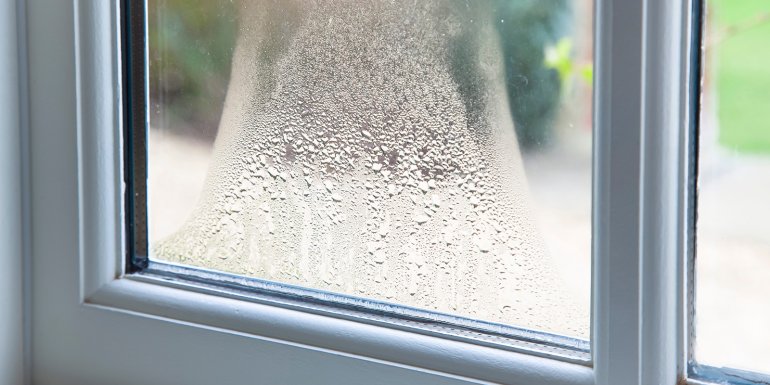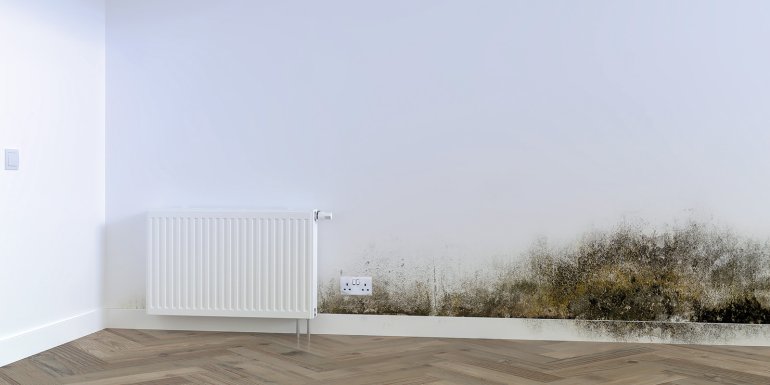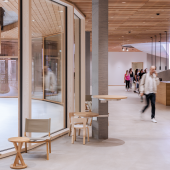Knowledge is power

As the Social Housing Regulation Bill (including Awaab’s Law) is due to be considered in the House of Lords, MCABE Chartered Building Engineer Nigel J Wakefield discusses the causes and treatment of mould.
Since the tragic death of two-year-old Awaab Ishak in December 2020 from a respiratory condition caused by mould in the one-bedroom flat where he lived – rented by his parents from the housing association Rochdale Boroughwide Housing – the issue of mould in social housing and rented accommodation has appeared in the UK’s national and local press. For a decade, I undertook dampness inspections for social housing and local authority housing organisations. I am not about to excuse absent or bad landlords, as tenants have the right to expect decent living conditions free from mould. I’m simply presenting a professional’s view of the cause and how it can be rectified. Of course, owner occupiers also suffer mould and recent significant increases in energy costs are going to exacerbate this issue.
Housing associations and local authorities produce booklets on how to manage condensation in homes. The booklets are technically correct – but like the doctor telling you not to walk on an injured foot, it takes no account of the implications of following the advice. The good news is early intervention by the tenant can mostly control mould.
Catching mould early
Where cold bridging or cold spots exist, the development of mould spores is slow and usually starts at the same place each season. A vigilant eye during cleaning will spot a 10p-sized patch of mould and early treatment with mould killer will solve the problem for two or three months. This will necessitate treatments two or possibly three times a winter, and if treated early it’s quite simple as a preventative measure. A jam jar with one part bleach and four parts water applied to the 10p-sized patch of the mould with an old toothbrush, left to work for five minutes and then wiped off with a piece of toilet tissue will take but a few moments. However, if the 10p patch of mould is left untreated it will quickly grow to the size of a newspaper, and from there it can spread across a whole ceiling or wall. When it reaches this stage, it is beyond most tenants’ ability to treat.
Thermal upgrades
A significant part of the UK’s housing stock was originally built without concern for thermal performance. Many of these buildings have since been thermally upgraded, and we need to understand the consequences. One of the main changes has been the replacement of single-glazed windows with hermetically-sealed double-glazed windows, often set in PVCu frames.
In the pre-insulation era, most of the condensation (when it occurred) formed on the single glazing in the property. Although a nuisance, it was possible to wipe down the glazing to remove the excess moisture. Condensation is nothing new – early single-glazed PVCu windows often had a drain channel that directed condensation off the glass onto the external windowsill. The introduction of double glazing effectively moved the problem of condensation onto the next coldest surface in the property, such as lintels, window reveals and sills. These are less easy to wipe down, resulting in damage.
Lifestyle changes
Most properties built pre-1970 didn’t have central heating, and up to the 1950s they had open solid fuel fires in the main rooms. Later the coal fire was substituted for a single gas fire in the lounge – the only form of heating in the entire property. The solid fuel fires vented the products of combustion up the chimney flue to the outside air. In wet weather, residents dried their laundry on a clothes horse in front of the fire. The heat from the fire dried out the clothes, and the resulting moisture passed into the air and was drawn up the flue with the warm products of combustion to vent outside. Today, we have central heating. Tenants dry their clothes on the radiators and the moisture passes from the clothes into the air and around the dwelling, finally settling on a cold surface as condensation.
Many properties from this era had suspended timber ground floors. These floors were ventilated to keep the timber structure dry and free from rot. This ventilation under the floor permits air to pass through the property to outside air, and thereby moves moist air outside. Rise and fall sash windows and casement windows were fitted to these houses. None of them were built with draught-stripping so there was a change of air throughout the property, which helped remove the humid air from the inside to the outside. Modern windows are draught-stripped – indeed, in newly-built homes we test the property to confirm that it doesn’t leak air. Over time we have steadily removed the contingency provided by draughts to help remove some of the moisture created in the normal daily routine of life inside the home.
Condensation
Daily showers and regular clothes laundry puts more moisture into the air than the activity of our ancestors did. Showering is a particular issue because of the steam; cooking too, as gas cookers produce a litre of water vapour into the air for every litre of gas burnt. The manufacturers of these appliances recommend that you open the kitchen door to the outside (or window where no direct door exists) to ventilate this moisture. What isn’t made clear is that if it is open 25mm or less, it’s as good as useless for ventilating steam. It is important too for the tenant to keep the door between the kitchen and the rest of the home closed during cooking and until the steam is ventilated outside to prevent it from passing around the home.

As we’ve sealed up these older properties by blocking up fireplaces and fitting draught-proofed windows, some housing associations have fitted extractor fans. However, a common failure is not adjusting the door in the room with the fan. Building Regulations require a 10mm gap to be formed at the bottom of doors into kitchens and bathrooms where fans are installed. If the fan is drawing air out of the room, that air has to be replaced with air from inside the home.
In a way that can be demonstrated by drinking from a carton, the sides collapse inwards and only spring back when you take your mouth away from the spout. After a few minutes, the extractor fan will continue to run but will cease extracting unless air replaces that taken out of the room. The fan will not have the strength to draw air out of the room without the door gap.
Cold bridges
Cold bridges and cold spots are what cause moist air to dump condensation onto a wall or ceiling. Rather like taking a can of fizzy drink out of the refrigerator on a warm day, the warm moist air condensates on the cold sides of the can in the same way warm moist air condensates on a cold bridge. Cold bridges are areas of masonry that bridge between the cold external skin of brickwork and the warm internal skin. The bridge allows heat to escape outside because it touches the external skin of the wall.
The condensation that used to form on the single glazing of windows and doors now forms on the cold bridges of the lintels, window and door reveals and sills because they are colder than the double-glazed units. It is possible to insulate these areas internally, but to be effective this needs to be done when the new windows are fitted, and PVCu window installers typically don’t install this type of insulation.
Insulation
Cold spots are omissions of (or badly-fitted) thermal insulation. A common issue with ceilings happens when a tenant stores things in the loft, and in so doing causes the glass fibre insulation to ruck up so an area of the ceiling doesn’t have the insulation touching it. The insulation has to touch the ceiling to be effective – where it doesn’t it will suffer condensation.
The largest area of cold spot is often found at the eaves. The cavity wall extends upwards until it reaches the eaves soffit board, usually coincidental with the window heads. Above the soffit line only the internal skin is present so that there is no cavity space. Even if retrospective insulation has been installed into the cavity space of the wall, none will be present above the line of the eaves soffit because there is no cavity space to insulate.
Newly-built homes have this space insulated; however, this is an awkward place to get to retrospectively. The opportunity arises to insulate the eaves and connect the cavity wall insulation to the loft insulation if the fascia board is replaced. However, the people who install PVCu fascia boards and soffits typically don’t take that opportunity to install thermal insulation.
Sufficient heating
Omissions of thermal insulation and cold bridges that collect condensation are only part of the process for mould to develop. Consider two groups of high-rise flats: one has communal heating where the tenants pay a flat rate each week for central heating and domestic hot water, whether they use it or not. The other has individual gas-fired boilers serving each flat. Both groups of flats are of the same design, with obvious large cold bridges at the balcony connection to the lounge ceiling/floor. The group of flats where the heating has to be paid for weekly is (in my experience) well heated and suffers little or no mould issues at the cold bridge. The other group of flats, where the tenant decides how much heating is used, is far more likely to suffer mould at the cold bridge of the balcony to the floor/ceiling.

Or consider a refurbished 1930s house and two different tenants living in the property one after the other. The property has loft insulation to current standards, and the brick inner skin/75mm cavity/brick outer skin external wall has retrospectively installed thermal insulation. PVCu windows have been retrospectively installed to current standards. The first tenant moved to the property from a home that had electric convector heaters. They found the off-peak heating better to use and significantly cheaper, and didn’t experience mould issues. The subsequent tenant didn’t want to operate the off-peak heating continuously and so had issues with mould at cold bridging of lintels over windows.
Irrespective of failings in the building construction, if the tenant heats, ventilates and controls the generation of moisture inside their home, the potential for condensation and mould is significantly reduced. Even if we insulate to remove the cold bridges and cold spots, the moisture present in the air will merely condensate on the next coldest surface – and that is why ventilation is key.
The UK has an oceanic climate, with cold and moist winters, which affects the ability of a property to dry out. Most countries that are part of large land masses have a continental climate and tend to be much drier. Those new to the UK and those who are too young to remember life before central heating and double glazing will be inexperienced in dealing with the excess moisture that can cause condensation and mould issues.
While it is true that lifestyles are contributing to the moisture levels in properties and that it’s within the occupants’ power to take action, it is also going to take more than a booklet from the local housing association. Not all tenants can dry their laundry externally or have access to a tumble drier. Not all tenants can open their bathroom or kitchen windows to ventilate steam. Not all tenants can avoid using portable heaters. Not all tenants are to blame for inadequate heating in their flats, or for the heating in empty adjacent flats too. And if a tenant wants to take a 20-minute shower, that’s their prerogative. So what can be done?
Property owners need to work with the tenants to recognise and deal with mould at the earliest stage. Owners need to consider how the property can be better ventilated in a way that works for the tenants to ensure success – and how it can be more efficiently heated for the benefit of all.
Meeting legal standards
The Housing Health and Safety Rating System (HHSRS) is used to assess risks in homes and covers a range of 29 potential hazards (including common issues such as damp and mould), assessing how dangerous they are in a specific property.
For a property to meet legal standards – under the Decent Homes Standard – it must be free from hazards at the most dangerous Category 1 level.
If a local council finds a Category 1 hazard, it has a legal duty to take action under the Housing Act 2004, including requiring landlords to fix issues, prohibiting the use of part or all of a building or carrying out emergency works themselves.
The government has finished its review of the HHSRS tool and its findings are due to be published.
For updates, visit bit.ly/GOV_update










